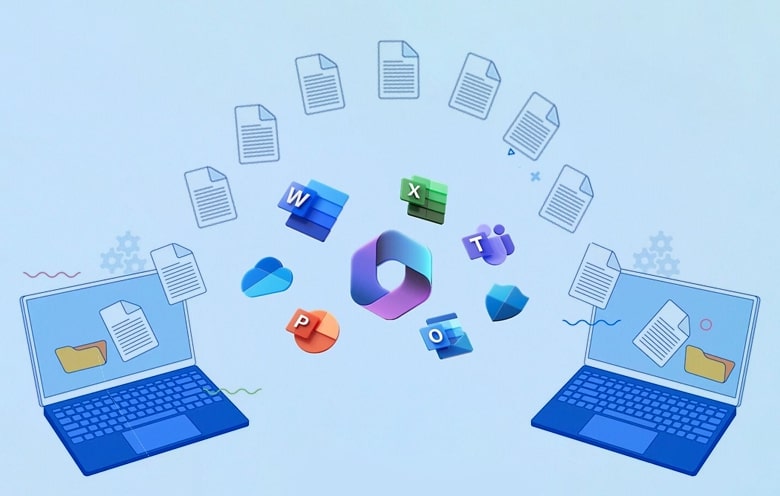Microsoft 365 has become the backbone of countless organizations, offering a suite of powerful tools and services that enhance productivity, collaboration and security. Nevertheless, there is a crucial factor to consider: time is rapidly diminishing.
Failure to migrate promptly may leave you behind your competitors. It is highly recommended not to delay any further. Start leveraging the benefits of Microsoft 365 to stay ahead in the constantly evolving business landscape of today.
Migrating to M365 can transform how you work. With this solution, you can access your files, migrated mailbox and applications from any device and location, at any time. Collaboration with colleagues becomes effortless, as if you were in the same room. Additionally, Microsoft 365 offers top-notch security features to protect your data from cyber threats.
By embracing the latest innovations and updates in Microsoft 365, your organization can remain technologically advanced and competitive.
Postponing your M365 tenant migration comes with risks and drawbacks, including:
- Inefficient resource allocation: Outdated Tenants limit productivity and hinder your competitive edge.
- Compatibility issues: New updates may cause collaboration and functionality problems in older Tenants.
- Data fragmentation: Delaying migration leads to fragmented data across multiple platforms, making management challenging.
- Increased costs: Outdated Tenants lack cost-saving features and scalability, resulting in higher expenses.
Key factors to keep in mind when transitioning to Microsoft 365
If you are considering migrating to Microsoft 365, there are a few things you need to do:
- Choose a migration partner: There are many reputable migration partners available who can help you with the migration process.
- Plan your migration: It is important to carefully plan your migration to ensure a smooth and successful implementation.
- Test your migration: Post migration, it is important to test it to ensure it works properly.
Migrating to Microsoft 365 can be a complex process, but it is worth the effort. By migrating to Microsoft 365, you can unlock the potential of your organization and improve your productivity, security and cost savings.
In this blog, we will discuss the fundamentals of M365 Tenant-to-Tenant migration. We will cover the challenges you may encounter and the benefits it can provide for your organization.
What is Microsoft 365 tenant-to-tenant migration?
Microsoft 365 tenant-to-tenant migration involves transferring data, user accounts and settings from one Microsoft 365 tenant to destination tenant. It includes moving your business resources like user mailbox, documents, applications and collaboration tools to a new environment. This complex undertaking requires careful planning and the assistance of a reputable migration service provider to ensure a smooth transition.
Impact of insufficient planning in Microsoft 365 tenant migration
Poor planning of your Tenant-to-Tenant migration can cause challenges and issues, affecting your business productivity and efficiency. Migrating to a new tenant poses potential problems such as data loss, service disruptions, security vulnerabilities and incomplete migration. Addressing these risks ensures a smooth transition.
Why you might need to migrate to a new Microsoft 365 tenant
There are several reasons why organizations consider migrating to a new Microsoft 365 tenant:
Merging or acquiring another company: When companies merge or acquire one another, it becomes crucial to consolidate resources and harmonize IT infrastructure. Migrating to a new Tenant allows for a unified environment and facilitates smooth collaboration.
Revamping your brand identity: Transition to a new tenant to reflect your updated company name or rebranding efforts. This ensures consistency across email addresses, source domain names and collaboration tools, reinforcing your refreshed brand image.
Meeting growth and scalability demands: Outgrowing your current Tenant necessitates a migration to a new one. This allows you to accommodate an expanding user base and increased storage requirements, ensuring smooth operations and optimized productivity.
Migrating to a different cloud provider: Seamlessly move to a new tenant when migrating to a different cloud provider. This enables you to leverage the unique features, improved performance and potential cost benefits offered by your chosen cloud platform.
Now that we’ve explored the reasons why you might need to move to a new Microsoft 365 tenant, let’s delve into the exciting benefits this transition can bring to your organization.
Key benefits of migrating to a new tenant
Migrating to a new Microsoft 365 Tenant offers several compelling benefits that can positively impact your organization’s operations and productivity.
Reduced costs: By integrating your resources into a new tenant, you can optimize your infrastructure and take advantage of cost efficiency. This consolidation eliminates redundancies and lowers maintenance costs, ultimately reducing your overall IT expenses.
Improved security: Migrating to a new tenant enables you to implement the latest security measures and best practices in Microsoft 365 ecosystem. You can benefit from enhanced data encryption, robust access controls, advanced threat detection and proactive security monitoring. This strengthens your security posture ensures sensitive information protection and safeguards against cyber threats.
Increased flexibility: The Microsoft 365 tenant provides you with the opportunity to customize your environment according to your specific needs. You can choose features, applications and services that align with your organization’s goals and workflows. This flexibility enables you to create a tailored digital workplace that enhances collaboration, communication and overall efficiency.
Streamlined management: Migrating to a new tenant allows you to streamline your administrative tasks and simplify user management. You can establish new governance policies, optimize user roles and permissions and implement automated processes for user provisioning and deprovisioning. These measures contribute to a better user experience, reduced IT overhead and improved compliance adherence.
What are the costs associated with migrating to another tenant
While migrating to a new Microsoft 365 tenant brings numerous benefits, it’s essential to consider the associated costs. Understanding these costs upfront will help you plan your budget and allocate resources effectively.
Here are some common costs you may encounter during the migration process:
Time: Migrating to a new tenant can be a time-consuming process, particularly if you have a large volume of data and a substantial number of users. The duration of the migration depends on factors such as data complexity, network bandwidth and the chosen migration method. It’s crucial to allocate sufficient time for planning, testing and executing the migration to minimize disruption to your business operations.
Financial investment: Depending on the complexity of your migration and your organization’s internal capabilities, you may need to enlist the services of a migration service provider. Hiring professionals with expertise in Microsoft 365 migrations can ensure a smooth and successful transition. While this incurs a financial cost, it saves you valuable time, reduces the risk of errors and ensures a seamless migration experience.
Resources and migration tools: There are various migration tools available on the market, each with its own pros and cons. Choosing the right tool for your migration scenario is crucial. Some tools automate the migration process, simplifying data migration and user provisioning tasks.
However, these tools may require additional licensing fees or expertise to configure and manage effectively. Assessing your requirements and selecting the appropriate tools will lead to successful migration process.
What are the challenges of migrating to a new tenant
As with any major IT undertaking, migrating to a target tenant carries inherent risks that need to be addressed and mitigated. Understanding these risks allows you to plan and execute a migration strategy that minimizes potential disruptions.
Here are some common risks associated with Microsoft 365 tenant-to-tenant migration:
Data loss or corruption: Improper migration practices or technical glitches can result in the loss or corruption of your data. To mitigate this risk, it is important to have robust backup mechanisms, perform thorough testing and closely monitor the migration process.
Disruption to business: Inadequate planning and execution can cause disruptions to your day-to-day operations. This can include downtime, loss of access to critical resources and interrupted communication channels. To minimize this risk, develop a detailed migration plan, conduct thorough testing and communicate effectively with your team.
Security breaches: During the migration process, there is always a risk of security breaches if proper security measures are not implemented. It is crucial to follow best practices for data encryption, access controls and network security. These measures ensure the confidentiality and integrity of your data throughout the migration process.
User adaptation and training: Migrating to a new tenant often introduces changes to the user interface, workflows and features. This can result in a learning curve for your employees, potentially affecting their productivity during the transition. To mitigate this risk, provide comprehensive training and support to help users adapt to the new environment quickly.
Migrate to Microsoft tenant now!
In conclusion, migrating to a new Microsoft 365 tenant is a significant undertaking that requires careful planning, consideration of associated costs and proactive risk management. By understanding the benefits, challenges, costs and risks involved, you can make informed decisions. This will help you develop a migration strategy that minimizes disruptions and maximizes advantages for your organization.
Stay tuned for the next part of our blog series, where we will delve deeper into the technical aspects of Microsoft 365 tenant-to-tenant migration projects. We will explore different migration methods, best practices and tips to ensure a successful and seamless transition. Remember, choose the right Microsoft 365 consulting service provider and tools to significantly simplify the process and contribute to a smooth migration experience.









